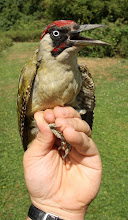This 'restaurant' is exclusively for birds - but does get raided by the occasional hog (of the spikey hedge variety) during the night. Regulars to this feeding table at my dad's house are many. Here are but a few:

Above: This coal tit grabs a take away (they never eat in).

Above: Many years ago, my dad would be gardening and would be visited by Snowy - a blackbird with a few white feathers. He even got Snowy to feed from the hand. The blackbird above is not Snowy, but we presume one of several descendants. Son? Grandson? Great Grandson? Who knows, but a regular visitor none the less.
There were at least 6 different blackbirds visiting the garden (5 seen at once + the one pictured above). Across the road, between 15 and 20 blackbirds were seen (all at once) underneath 2 apple trees eating the fallen apples.

Above: A relatively new visitor to the table. This Pied Wagtail, being the first of this species (that we know of) to visit the garden, was noted by my dad for its unusual yellow face. In fact, this bird is experiencing its first ever winter and the yellow face is typical of Pied Wagtails of this age. It will, at some point this year, replace the yellow with the white found in adult birds.
Pied Wagtails are not alone in having yellow faces (while in juvenile plumage). Blue Tits and Great Tits have this too, although they have lost this feature almost entirely by the autumn.
Last year I went on a walk with my dad in the Cotswolds near his house. I saw a flock of 200 + chaffinch & some brambling & some yellowhammers & 200 + Fieldfare & Redwing all in one place. This year a walk in the same area revealed 200 + chaffinch (mostly male & including some yellowhammers). Maybe when (if) I get my C permit, I will get to ring these. Assuming that they are there next winter!















